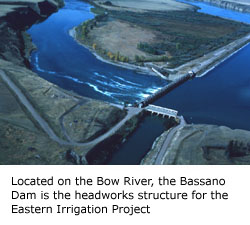
As these adjustments have benefited the agricultural economy, new and growing demands for water have arisen. More water is needed for urban domestic and industrial purposes, as well as for large-scale irrigation. This made necessary the development of larger, more comprehensive water storage and irrigation schemes where more dependable and plentiful water supplies could be obtained. Irrigation has permitted intensification, diversification and economic security of many dry regions across the Prairies.
PFRA has constructed a network of dams, diversion structures and water distribution
infrastructure for
irrigation projects in this drought-prone region. The projects provide farmers with irrigable
hay-land,
and help assure stabilized forage supplies to maintain a livestock population in the region. The
storage
reservoirs also provide a secure supply of water for many farms and several communities.

Major irrigation projects were undertaken on a cost-and-work sharing basis by agreement between the federal government and the province concerned. These projects because of their size or location, required special authorization from Parliament and were covered by financial votes separate from the regular PFRA appropriation. Responsibility for the development and supervision of these projects rested with PFRA.